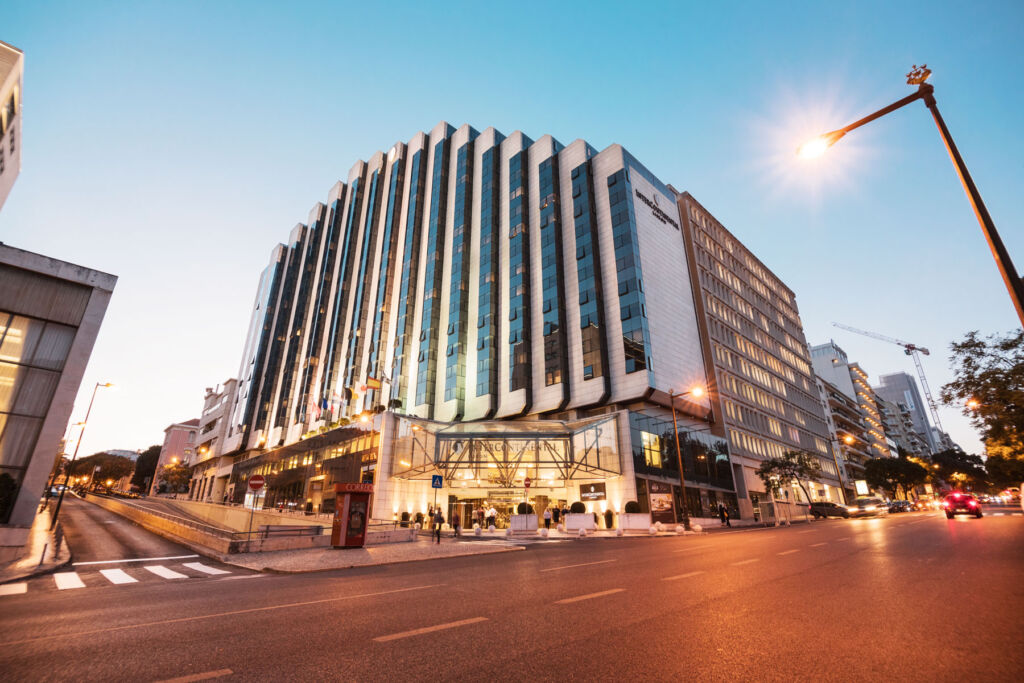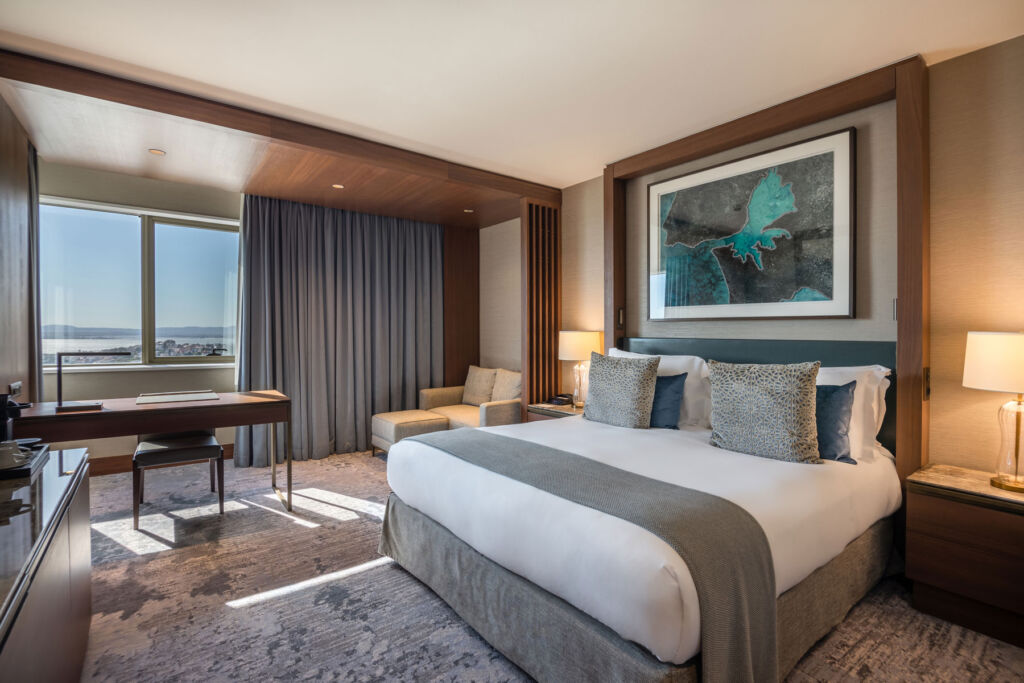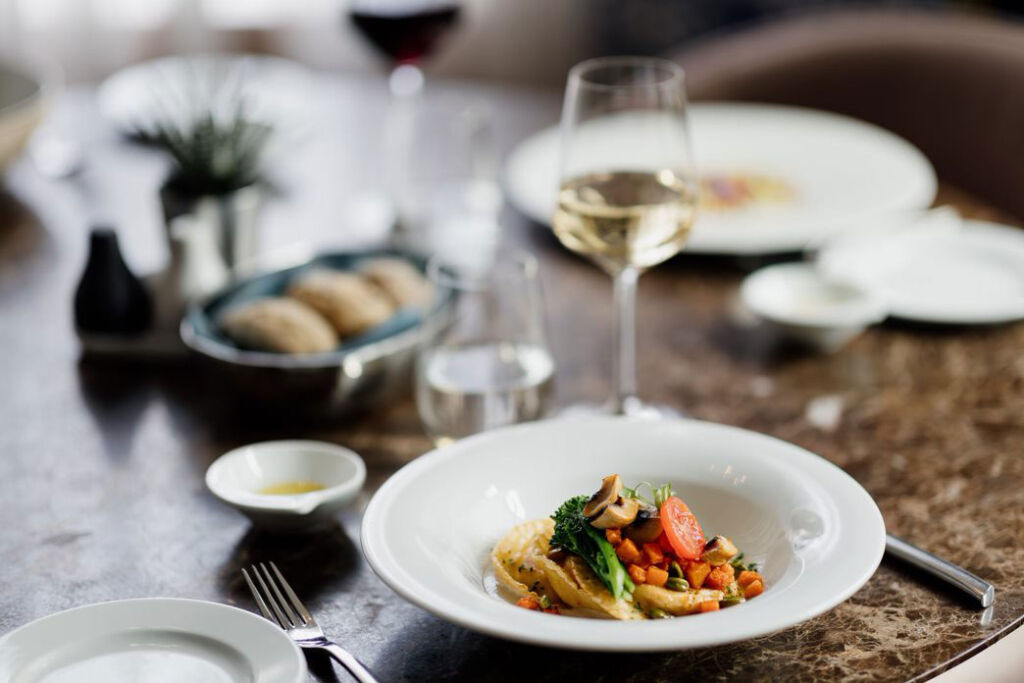

Lisbon is hands down one of the coolest European cities. It has a vibrant history, stunning architecture, is full of culture, has a myriad of views and a burgeoning food scene. And to take it all in, Sabi Phagura was invited to stay at InterContinental Lisbon before heading over to explore Cascais from the delightful and charming InterContinental Cascais-Estoril boutique hotel.
Towering high above Lisbon’s skyline overlooking the green oasis that is Eduardo VII Park and the Tagus River, InterContinental Lisbon (main image above) has an enviable location from which to explore. Walking through the glass doors and the hotel itself surpassed my expectations.
The elegant lobby area, with its glittering bulb-themed chandeliers and the blue and gold hues of the seating area, was a welcome hug. After a swift check-in by friendly staff, I was ready to take the weight off my feet in my 12th-floor river view room.


The décor of the 331 rooms includes 17 suites, which were refurbished just before lockdown, are minimalist following neutral tones with plenty of dark wood panels to give them a regal look.
With plenty of light streaming in from the windows, looking out across to the city with a coffee in hand from the Nespresso machine was magical. Luxury and comfort seem to come easily for this hotel.
The food


We dined incredibly well at the hotel, which was just as well with the amount of exploring that was packed into our two-day stay. Situated just off the main lobby area, the 75-cover Akla restaurant (below) is an inviting space with its stylish décor, especially the brightly coloured typical Portuguese tiles gracing the wall.
Guests can expect to sample local flavours with cleverly combined international techniques by talented Chef Eddy Melo. Prices are incredibly reasonable, with the set lunch menu setting you back at just 17.50 euros.
The ultimate showstopper is the Chef’s Table, where Eddy (above) and his team concoct dish after dish right in front of guests. It’s theatrical dining at its best as we not only tucked into the various flavours and textures but learned about the origins of food, which was presented beautifully.
The fish dishes, which the Portuguese are famed for, were my favourite, while the plate of delectable desserts helped balance the sugar with the flavours after the savoury courses.
The cosmopolitan and elegant Uptown Bar (above) situated next to Akla restaurant is where guests can head for pre and post-dinner drinks. Its plush sofas are akin to a fancy living room. Once reclined on the sofas and chairs, it proved hard to get off them.
Guests checked into the suites also have exclusive access to the Club Lounge, where complimentary drinks and canapes are served from 5 pm until 7 pm daily. They may also have a secluded, intimate breakfast here, away from the crowds.
But if, like me, you like a bit of people-watching, then the Eduardo VII Room on the first floor serves a generous buffet breakfast of fruit juices, Viennese pastries, cereals, cheeses and cold cuts, pancakes, yoghurts, fresh fruits, coffee, tea and hot chocolate.
Meeting rooms
The 5-star InterContinental Lisbon appeals to both the luxury and business traveller. But nothing is boring about the conference and meeting rooms here, thanks to their clean, elegant designs.
The large foyer, with natural daylight, can hold 250 people and is perfectly suited for meetings, cocktail parties and even weddings. A further seven dedicated meeting rooms leading from this area can be used for meetings, functions and social events.
The 360 sqm Ballroom is one of Lisbon’s highest ballroom ceilings, with a height of 5.5 metres. It was empty during our stay, but pictures shown to us of the place kitted out looked marvellous.
Things to do
Lisbon, as I mentioned above, has a plethora of things to do and see. And we did our best to cram in as many activities as we could in 48 hours. One of our first stops was a tour of the Belém district. The area is located on the Tagus River and is known for its seafood restaurants and houses decorated with colourful tiles.
We got a close-up look at Mosteiro dos Jerónimos a palatial monastery that rightfully graces many postcards in the capital. King Manuel I ordered it in memory of Prince Henry the Navigator.
Marvelling at the intricate and elaborate designs, impressive cloisters and stonework, I wasn’t at all surprised to learn it took almost a century to complete from its humble beginnings in 1501.
Portugal’s Age of Discovery is another monument you shouldn’t miss visiting. The imposing cream building, depicting 33 historical figures, was built in the 1960s as a homage to the country’s contribution in the 15th and 16th centuries.
We couldn’t help but make a cheeky pitstop at Pastéis de Belém to try Portugal’s national dessert, pastéis de nata. Baking since 1837, the shop is famed for being the best place to sample flaky pastry with a warm and gooey custard centre. A staggering 20,000 are sold daily.
Queues regularly snake around the building to either have a pastry or two on the go or wait to be seated inside to pay their full undivided attention to this sweet dessert. We did the latter, and I had to agree that there’s a lot to love about this moreish sweet treat. First created by monks, the family-run bakery keeps the recipe a closely guarded secret.
As it’s not possible to survive on pastéis de nata alone, there are plenty of opportunities to sample excellent Portuguese cuisine. The delightful Mini Bar is one to head to if you like a bit of glitz and glamour, especially the private dining space through a secret door. Lota D’Avila is an eatery for fish and seafood lovers, who will find a single fish covering an entire platter.
Exploring the city on foot is great, but you can also see it from the sea aboard a boat. It was mesmerising, admiring the city highlights as we sailed along the Tagus River on one of the mornings. You get a totally different vantage point from a yacht or sailing boat.
Lisbon has a cracking street art scene, and one of the best ways to get your fix is by booking a tour aboard a Tuk Tuk. Tejo Tourism runs fantastic tours where their knowledgeable guides take you around the city to highlight the artwork.
As we hurtled down various streets, including the famous Avenida da Liberdade cram-packed with stylish shops, we had the chance to look at some cracking masterpieces adorning the walls all over. The Panda by artist Bordalo II is a 3d artwork made entirely from recycled rubbish and is a real gem.
If history is your thing, then it’s worth descending the steps from Miradouro de Santa Luzia to look at the History of Lisbon Mural. Hidden beneath a beautiful overlook and next to a public toilet, you’ll find the port city’s past depicted in a giant comic strip format.
Lisbon’s 1755 earthquake was a disaster that would change the face of the city forever. The natural disaster took some 60,000 lives in Lisbon alone and damaged 12,000 dwellings and large buildings. It took a complete rebuild of the city for some semblance of normality to return.
InterContinental Cascais-Estoril
While it was sad to leave Lisbon behind, I am pleased to say we had the opportunity to go on to explore Cascais from the boutique InterContinental Cascais-Estoril Hotel. Just a 25-minute drive away, in my opinion, this resort town must be part of any trip to the capital.
It’s also served by the tiny Monte Estoril train station, which is directly outside the hotel, making it a popular place for locals to commute to and from Lisbon.
The hotel is just a short walk from the 20th-century Casino in Estoril, which was allegedly what inspired Flemming’s, Casino Royal. Part of the InterContinental group, this hotel has magnificent Atlantic Ocean views from the third-floor lobby. Furthermore, all 59 rooms and suites face the ocean.
My recently decorated junior suite on the second floor was nothing short of outstanding from where it was possible to have a bath while watching the sea through the glass-panelled wall of the bathroom.
Combining comfort and a sophisticated design with blue accents reflecting the sea, the spacious rooms and suites are luxuriously furnished with contemporary-styled interiors, all with private terraces. Simply stunning.
The lobby, with its fresh flowers and shiny floor, is the hotel’s hub from where you can dine in their all-day gourmet bar and terrace restaurant, Bago Du Vin. While Cascais and Estoril have a mild microclimate, the huge sliding patio windows overlooking the pool can be closed if need be.
A small and intimate bar with a cupboard-sized cheese and wine room is the perfect place to grab a drink and a snack. Staff are equally happy to serve refreshments to guests wanting to get closer to some water action by the outdoor pool.
Villa Atlântico is a charming events area that offers indoor and outdoor spaces and can be creatively transformed according to guests’ needs. It offers elegance and charm no matter what the occasion. The meeting rooms also lend themselves to being adapted to suit clients and customers’ needs.
Guests can admire paintings from local artists (available to buy) all over the hotel, so don’t miss checking these out, especially the impressive 3-d ones by Pedro Guimarães in the meeting areas.
Before we even began to explore our surroundings, a massage at the SPA InterContinental by L’Occitane beckoned. It certainly helped to rejuvenate and relax us after Lisbon’s intense tour. Treatments include a plethora of traditional treatments from an impressive menu. Further, “r and r” can be found in the shape of an indoor pool with a waterfall, sauna and steam bath.
Once again, we were wowed by the food in this part of the country. Again, plenty of fish dishes meant we had our protein fix while the meat eaters were satisfied with steaks and the like. But for me, it would be amiss of me not to try fresh seafood, particularly when you’re by the sea.
Things to do
The coastal promenade directly outside the hotel makes for ideal early-morning walks and will also take you into the centre of Cascais in 20 minutes. With food being high on the agenda, we head to Cascais FoodLab inside the local market Mercado da Vila.
Rather than wait for our food to be cooked, we ‘mucked in’ and created dishes with the help of Chefs Julia and Francisco. The lab was set up to provide a meeting point for everyone from students to professionals who have a common love and appreciation of gastronomy.
With the sleeves rolled and gloves donned, we chopped, fried and stirred in the ingredients for our three-course lunch. Spicy Prawns, Monkfish Rice and Orange Swiss Rolls were all made with enthusiasm and gusto. It never ceases to amaze me how simple food can taste so good. We even got presented with a certificate to say we had completed the course.
But of course, you don’t have to work for your food and can always head out to some of the fantastic restaurants in the region. I can highly recommend Furnas do Guincho with its breathtaking views of the Atlantic and the Cabo da Roca. The seafood and fish were of impeccable quality at both.
The region of Cascais and Estoril is full of beauty, and, like Lisbon, it has an amazing history. Almost everything is within walking distance, and you don’t need a boat to walk around the marina. With plenty of shops, cafes and bars, you can easily while away the entire day.
Culture vultures will want to make the most of their vacation with a visit to Sintra and Palacio de Pena. It’s best to get a tour guide as they can offer you in-depth knowledge of the area and steer you away from busier times.
Our guide André from Shortcuts Tourism, was invaluable as he showed us around, pointing out all the things we may have missed if we were viewing the area solo. The palace is quite possibly one of the finest tourist attractions here. Completed in 1854, it sits atop a hill above the town of Sintra and, thanks to its vivid colours, can be spotted from Lisbon on a clear day.
The palace is a beautiful example of the Romanticism architecture style from the 19th century.
The brightly coloured terraces and statues of mythological creatures adorn the exteriors while the interiors have been restored, allowing visitors to feel they had gone back to 1910 when it was vacated.
Pena Park surrounds the palace and is a vast forested area spread out over 200 hectares, and it surrounds the palace. It’s filled with walking paths, secret paths, pavilions, lakes, ponds and exotic trees and a joy to wander around. It was designed on the orders given by King Ferdinand and offers plenty of sanctuary moments from the crowds of the palace.
And, of course, no trip to the ocean is complete without getting up close and personal with it. The sunset cruise with Palma Yachts was just the ticket to breathe in the fresh sea air before heading back home with a head full of amazing memories.
InterContinental Lisbon and InterContinental Cascais-Estoril – Where and How?
InterContinental Lisbon can be found in Rua Castilho 149, 1099-034 Lisbon – Portugal. More information can be found at www.iclisbonhotel.com.
For information on InterContinental Cascais-Estoril, visit www.estorilintercontinental.com/en/, which is located in Avenida Marginal Monte Estoril.
Read more travel reviews, guides and hospitality news here.
